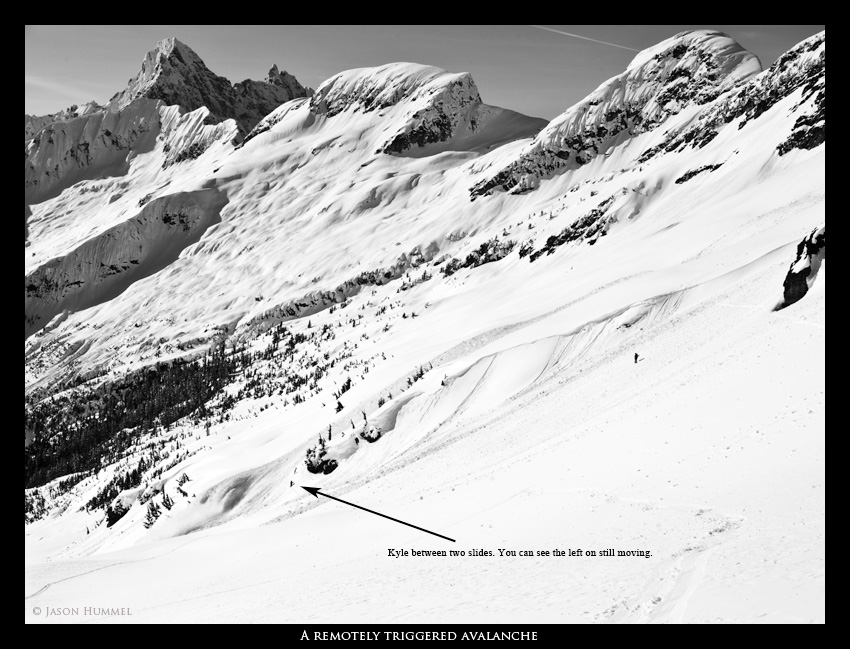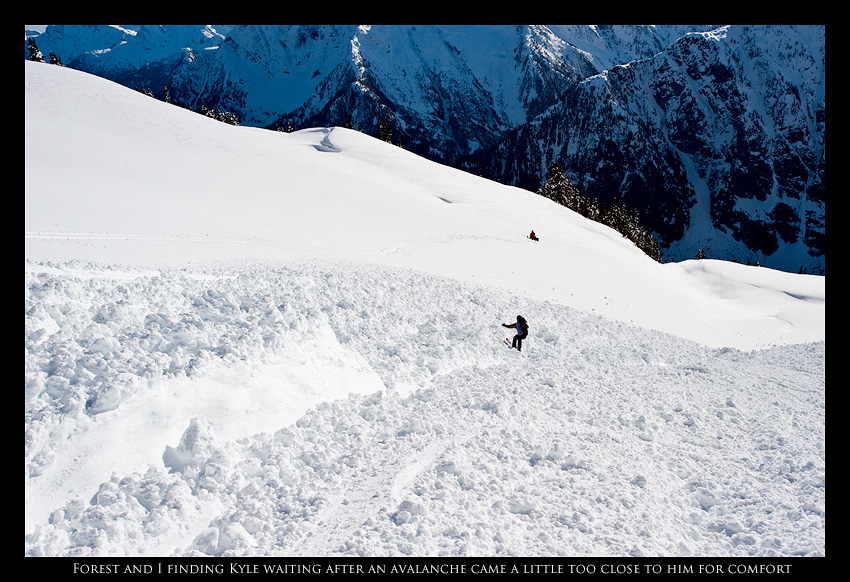Over the years I’ve been fortunate to learn a lot about avalanches, from the weather to the terrain that causes it. In the beginning I learned through experience but in the past few years I’ve had the good fortune to get training though the Canadian Avalanche Association receiving my professional level 1. In the near future I hope to give clinics not only about avalanche education but a well rounded knowledge of what, when, where and why when it comes to Splitboarding. But here is a quick breakdown of what I learned and how I feel is a good way to apply it.

As my wife and her sister are preparing to go to Japan I took them out for some search training and I thought I would write down some of the tricks I used to make the situation as realistic as possible in preparation for and if something does happen so that they will have the skills necessary to work both fast and efficiently. Not only focusing on what to do but more importantly what not to do.
Tricks to help people learn and make the environment more realistic.
- The first and one of the most important things is that you should do your training with all the gear you plan on using throughout the season from your beacon to the ski pants to the backpack, basically everything that you intend on using. This familiarity with your gear is absolutely vital as what good is training with a different beacon than getting in a disastrous situation and not knowing how your beacon works or finding potential flaws in your gear or layout of your backpack when it is too late.
- Start from scratch- I think it’s really important to do the first search practice without any insight from the instructor. This gives you a starting point and helps you get an idea of where you are starting from and after that first search practice then the teacher gives the input of what went wrong, what to do and how to do it. This shows instant progression and gives you a realistic base of where you are starting from and where you have progressed to.
- Its vital to have them search for multiple beacons- 1 beacon can be considered easy, 2 beacons is a bit harder but real skill develops when you start looking for 3. This will develop essential skills in a real world situation and will allow the opportunity to show how to properly search terrain for other people. If you only search for one beacon and you find yourself in a situation where multiple people are buried this tip alone can be the difference between someone surviving or multiple fatalities.
- Don’t have multiple people searching at one time (especially in training) as you should really have each person develop the skills of being a leader not to say you can’t have people help but each person needs to take the lead and have the proper skills in case they are the one who finds themselves in the situation and they know what tasks to give to other people.
- Once you have chosen the specific person training as the leader and if you have another person helping send the second person out with there beacon in send mode and don’t let them switch over until the leader has stated “switch over to search mode” I’ve been in situations where people were looking for a person and they were getting beacon interference from numerous other searchers and this not only slows down a process, it is downright disastrous in a time in which every second is vital.
- Now this is personal preference but make the people do a minute of jumping jacks before the search. This leaves them somewhat exhausted before starting the search. I can’t think of a single situation where my body was fresh as I found myself in an avalanche situation. You can have them do this on the second attempt and even better on the third attempt.
- As I stated above when training others don’t give any input on the first search until it is finally concluded. This allows the trainer to see the mistakes that the person made, then you can get to the specific things that went wrong any why. This lets them experience what went wrong and through communication, hopefully they won’t make that mistake if the occasion arises.
- If you can make them search through deep snow as I can’t think of a single time I’ve been around an avalanche and walking around wasn’t an exhausting experience. Running around in a plowed parking lot and finding a beacon in 2 minutes gives people a false sense of “I can do this” but trudging through knee deep snow lets them know “No part of this is going to be easy”.
- Once the first search is over make the person leading tell the helper specific tasks to do for example “ The signal is coming from here…probe here!” You want them to think through the process properly and state out loud what needs to be done as someone has to take the leadership position
Now Lets Get down to the Search

- First establish when and where the person was last seen before and during the avalanche Secondly make sure that by/when checking the area you are not exposed to another potential avalanche before you switch your signal over to search mode. It is sad when someone loses there life but it’s even worse if 4 more people got buried while searching for other people and it’s now 100 times harder to find people since there beacon is now in search mode.
- . Now someone needs to take the leadership role and tell everyone surrounding to switch over to search mode before giving others specific jobs (probing and shoveling) as you are on a limited time schedule and every second counts.
- Make your way down the slope in a grid like pattern, carefully traversing a section than drop 2 feet before traversing in the opposite direction. It is very important to do a top to bottom search as a bottom to top grid will take much more energy and time climbing the slope in waist deep snow. when in a situation of multiple burials or the potential even if you pick up a signal still follow the grid pattern layout but at a faster pace. Backtracking to your original spot will take far more time and energy and you may forget exactly where you left the grid pattern.
- Once you have located the spot in the snow that has the strongest signal quickly run your beacon in a cross pattern as low to the snow as possible so you have the exact spot where the burial is before probing. In the case where you have multiple searchers you should have already told people to have there probe and shovel ready so that they can quickly hand you the probe.
- After probing in a outward spiral technique and finding the exact spot leave the probe in the location and tell the other person to start digging a foot below where you made contact. It is much easier to remove snow downslope and not strike the person with the shovel, potentially causing an injury. If alone dig the person an airway then get back to searching for the next person and if there are others once you have made the beacon strike start searching for the next person immediately while the others are digging. If there is only one person buried it’s time to get out your shovel now and dig as fast as you can.In the situation that there are multiple burials make sure to use the masking function on your beacon for the first burial than move on towards the next person following the grid pattern so you can thoughogly search the area. It is vital that you stay on the grid pattern to have the best results in searching.
- Once the person or people have been dug out you don’t immediately start moving them around as there is a big potential that they could have endured trauma on the way down so inspect the person. Get any info if they had partners in the avalanche and if they are okay make your way down to the base.
This write up is a mixture of what I learned training for a Canadian Level 1 professional certification and what I’ve learned over time. I highly recommend doing this training numerous times throughout the season as well as taking training from a professional as you NEED to have everything dialed in preparation for the time that you find yourself in an avalanche situation.
Now terrain, travel and avalanche types is another topic all together. Some people may agree with my system while others disagree but I personally found it to be the most effective when I was doing my testing as I left the grid system approach my first time only to fail the test I felt confident I would pass. The next time I stuck to the grid system search and had far superior results.
